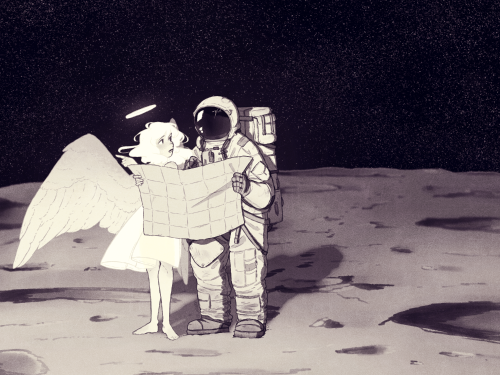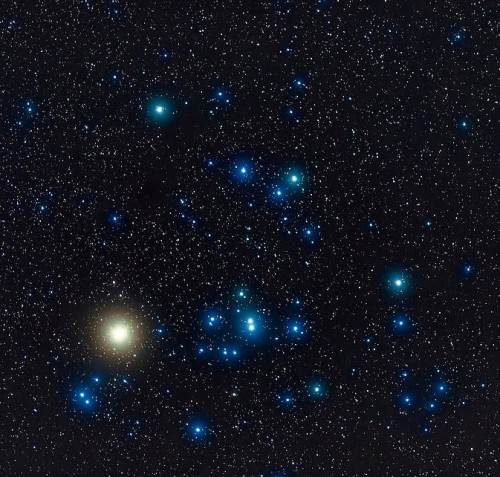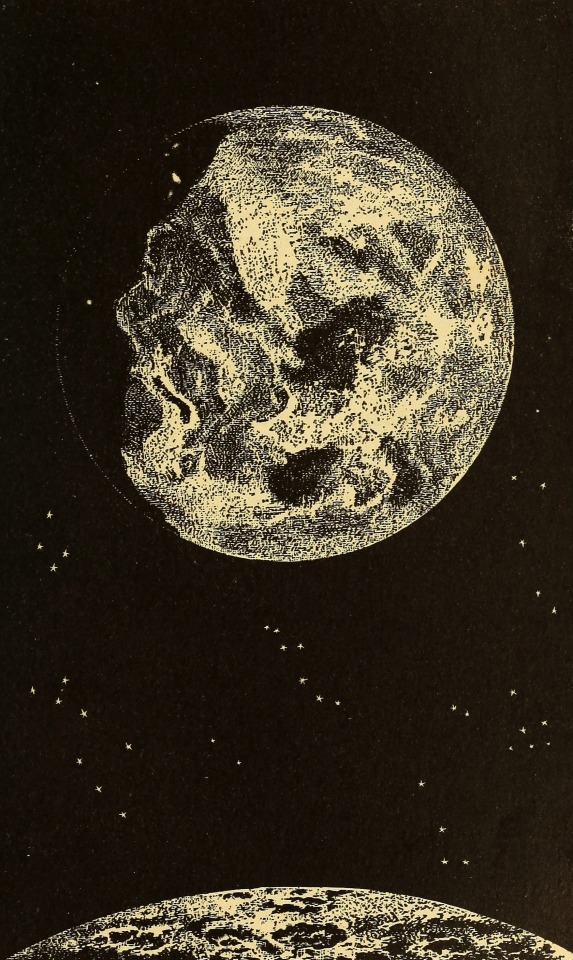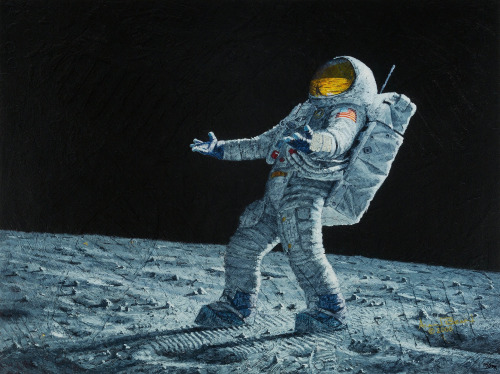Latest Posts by space-cute - Page 2


Mount Wilson Observatory, The Pleiades, M45, +/- 1950 United States.
Vintage silver print
Scary Space Stories to Tell in the Dark
The universe is full of dazzling sights, but there’s an eerie side of space, too. Nestled between the stars, shadowy figures lurk unseen. The entire galaxy could even be considered a graveyard, full of long-dead stars. And it’s not just the Milky Way – the whole universe is a bit like one giant haunted house! Our Nancy Grace Roman Space Telescope will illuminate all kinds of spine-chilling cosmic mysteries when it launches in 2027, but for now settle in for some true, scary space stories.

Flickering Lights
One of the first signs that things are about to get creepy in a scary movie is when the lights start to flicker. That happens all the time in space, too! But instead of being a sinister omen, it can help us find planets circling other stars.

Roman will stare toward the heart of our galaxy and watch to see when pairs of stars appear to align in the sky. When that happens, the nearer star – and orbiting planets – can lens light from the farther star, creating a brief brightening. That’s because every massive object warps the fabric of space-time, changing the path light takes when it passes close by. Roman could find around 1,000 planets using this technique, which is called microlensing.
The mission will also see little flickers when planets cross in front of their host star as they orbit and temporarily dim the light we receive from the star. Roman could find an additional 100,000 planets this way!

Galactic Ghosts
Roman is going to be one of the best ghost hunters in the galaxy! Since microlensing relies on an object’s gravity, not its light, it can find all kinds of invisible specters drifting through the Milky Way. That includes rogue planets, which roam the galaxy alone instead of orbiting a star…

…and solo stellar-mass black holes, which we can usually only find when they have a visible companion, like a star. Astronomers think there should be 100 million of these black holes in our galaxy.

Stellar Skeletons
Black holes aren’t the only dead stars hiding in the sky. When stars that aren’t quite massive enough to form black holes run out of fuel, they blast away their outer layers and become neutron stars. These stellar cores are the densest material we can directly observe. One sugar cube of neutron star material would weigh about 1 billion tons (or 1 trillion kilograms) on Earth! Roman will be able to detect when these extreme objects collide.

Smaller stars like our Sun have less dramatic fates. After they run out of fuel, they swell up and shrug off their outer layers until only a small, hot core called a white dwarf remains. Those outer layers may be recycled into later generations of stars and planets. Roman will explore regions where new stars are bursting to life, possibly containing the remnants of such dead stars.

Cosmic Cobwebs
If we zoom out far enough, the structure of space looks like a giant cobweb! The cosmic web is the large-scale backbone of the universe, made up mainly of a mysterious substance known as dark matter and laced with gas, upon which galaxies are built. Roman will find precise distances for more than 10 million galaxies to map the structure of the cosmos, helping astronomers figure out why the expansion of the universe is speeding up.

Learn more about the exciting science this mission will investigate on Twitter and Facebook.
Make sure to follow us on Tumblr for your regular dose of space!
𝐀𝐛𝐨𝐮𝐭 𝟏,𝟑𝟐𝟎 𝐥𝐢𝐠𝐡𝐭-𝐲𝐞𝐚𝐫𝐬 𝐚𝐰𝐚𝐲 𝐟𝐫𝐨𝐦 𝐰𝐡𝐞𝐫𝐞 𝐲𝐨𝐮'𝐫𝐞 𝐬𝐢𝐭𝐭𝐢𝐧𝐠 𝐢𝐬 𝐭𝐡𝐞 𝐩𝐫𝐞𝐭𝐭𝐲 𝐩𝐚𝐬𝐭𝐞𝐥 𝐩𝐥𝐚𝐧𝐞𝐭, 𝐓𝐎𝐈-𝟏𝟑𝟑𝟖 𝐛. 𝐀 𝐍𝐞𝐩𝐭𝐮𝐧𝐞-𝐥𝐢𝐤𝐞 𝐞𝐱𝐨𝐩𝐥𝐚𝐧𝐞𝐭 𝐭𝐡𝐚𝐭'𝐬 𝐚𝐥𝐦𝐨𝐬𝐭 𝐭𝐡𝐞 𝐬𝐢𝐳𝐞 𝐨𝐟 𝐒𝐚𝐭𝐮𝐫𝐧, 𝐚𝐧𝐝 𝐢𝐬 𝟔.𝟗 𝐭𝐢𝐦𝐞𝐬 𝐛𝐢𝐠𝐠𝐞𝐫 𝐭𝐡𝐞𝐧 𝐄𝐚𝐫𝐭𝐡. 𝐓𝐡𝐞 𝐩𝐥𝐚𝐧𝐞𝐭 𝐰𝐚𝐬 𝐟𝐨𝐮𝐧𝐝 𝐛𝐲 𝐖𝐨𝐥𝐟 𝐂𝐮𝐤𝐢𝐞𝐫, 𝐚 𝐡𝐢𝐠𝐡 𝐬𝐜𝐡𝐨𝐨𝐥 𝐬𝐭𝐮𝐝𝐞𝐧𝐭, 𝐰𝐡𝐨 𝐣𝐨𝐢𝐧𝐞𝐝 𝐭𝐡𝐞 𝐆𝐨𝐝𝐝𝐚𝐫𝐝 𝐒𝐩𝐚𝐜𝐞 𝐅𝐥𝐢𝐠𝐡𝐭 𝐂𝐞𝐧𝐭𝐞𝐫 𝐚𝐬 𝐚 𝐬𝐮𝐦𝐦𝐞𝐫 𝐢𝐧𝐭𝐞𝐫𝐧. 💫💗✨



Asking for directions

Plasma downflow single footpoint of quiescent solar prominence
been reading a lot of conversations about space since the james webb images were released particularly wrt to light speed and the fact that we are technically "looking into the past" because the light that actually reaches us is millions or billions of years old, and so we only see these places as they were when the light left, not as they are right now. cool & fine & very interesting
but i just saw someone (shoutout sylverthewordsmyth in the tiktok comment section) reframe this as "the future can see us" and despite this being a natural and logical extrapolation from us seeing the past, it has shaken me to my core. if there's anybody to look at us from far away, millions and billions of years in the future, they would look at us and see... us. they would look and see the same planet we live on right now, with the same continents and oceans. and it will be already long gone but to them it will be as alive as it is to us right now, the same way we see still see stars that have already gone out. i have to lay down


"We love our black hole"

Bright Rigel
Ok so Haumea, a dwarf planet beyond Pluto, spins so fast it gets elongated like this. This is just what it looks like. Something deeply unsettles me looking at it. Terrifying.



Hyades Star Cluster
![Belka & Strelka, Space Dogs, Gzhel Porcelain Shtof, Space, Rocket USSR, Handmade / [***]](https://64.media.tumblr.com/2e68626ae0462f6ac86208b742cd18c8/tumblr_pgfxnkOaEt1qzfmh5o1_r1_500.jpg)
Belka & Strelka, Space dogs, Gzhel Porcelain Shtof, Space, Rocket USSR, Handmade / [***]
![Belka & Strelka, Space Dogs, Gzhel Porcelain Shtof, Space, Rocket USSR, Handmade / [***]](https://64.media.tumblr.com/f5009fe39ced98a059c6082229afbd81/tumblr_inline_pgfy77gagM1qzdx6f_500.jpg)

i cant believe this is a real photo

i cant believe this is a real photo

This is another photo of the Jupiter Saturn Conjunction! 🪐🪐🪐
The two planets are getting closer each day! I love this picture because you can clearly see Jupiter’s 4 largest moons (Io, Europa, Ganymede, and Callisto) and a nice view of Saturn. This event is very rare - Jupiter and Saturn are the closest since the year 1623! ✨✨✨
Taken by me (Michelle Park) using the Slooh Canary Two telescope on December 20th, 2020 at 19:24 UTC.

This is another photo of the Jupiter Saturn Conjunction! 🪐🪐🪐
The two planets are getting closer each day! I love this picture because you can clearly see Jupiter’s 4 largest moons (Io, Europa, Ganymede, and Callisto) and a nice view of Saturn. This event is very rare - Jupiter and Saturn are the closest since the year 1623! ✨✨✨
Taken by me (Michelle Park) using the Slooh Canary Two telescope on December 20th, 2020 at 19:24 UTC.
Dreaming of going to space? – Astronaut Victor Glover has you covered.
In his first video from space, take a look at our home through the window of SpaceX’s Crew Dragon “Resilience” spacecraft. Victor arrived to the International Space Station alongside his fellow Crew-1 astronauts on Nov. 16, 2020.
This is his first trip to space and his first mission on the orbital lab!
Follow his Instagram account HERE to stay up-to-date on station life and for more behind-the-scenes content like this.
Make sure to follow us on Tumblr for your regular dose of space: http://nasa.tumblr.com.

NGC 346, Star Lily

NGC 346, Star Lily





Crux & Carina at Yerecoin, Western Australia
Nikon d5500 - 35mm - ISO 3200 - f/2.5 - Foreground: 3 x 6 seconds - Sky: 10 x 30 seconds - iOptron SkyTracker












Managed to capture some pictures of comet NEOWISE last night! It’s still a bit faint, but it does make for some pretty cool images-

Cosmonaut Ivan Vagner obtained this image of the comet NEOWISE a few hours ago from the International Space Station. He says that the dust tail looks very good from there. It is worth enlarging the image.
via reddit



Northern lights over the Giant’s Causeway.
(by Richard McManus)

“Is Anyone Out There?” Self-portrait by Apollo 12 astronaut Alan Bean, 2000.

Ring Galaxy AM 0644-741 by Hubble Heritage

Ojos del Salar, Atacama Desert

Observations made with ESO’s Very Large Telescope (VLT) have revealed for the first time that a star orbiting the supermassive black hole at the centre of the Milky Way moves just as predicted by Einstein’s general theory of relativity. Its orbit is shaped like a rosette and not like an ellipse as predicted by Newton’s theory of gravity. This long-sought-after result was made possible by increasingly precise measurements over nearly 30 years, which have enabled scientists to unlock the mysteries of the behemoth lurking at the heart of our galaxy.
“Einstein’s General Relativity predicts that bound orbits of one object around another are not closed, as in Newtonian Gravity, but precess forwards in the plane of motion. This famous effect—first seen in the orbit of the planet Mercury around the Sun—was the first evidence in favour of General Relativity. One hundred years later we have now detected the same effect in the motion of a star orbiting the compact radio source Sagittarius A* at the centre of the Milky Way. This observational breakthrough strengthens the evidence that Sagittarius A* must be a supermassive black hole of 4 million times the mass of the Sun,” says Reinhard Genzel, Director at the Max Planck Institute for Extraterrestrial Physics (MPE) in Garching, Germany and the architect of the 30-year-long programme that led to this result.
Continue Reading.